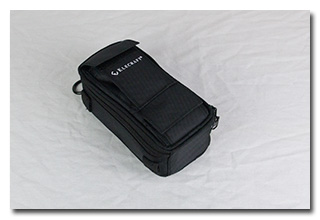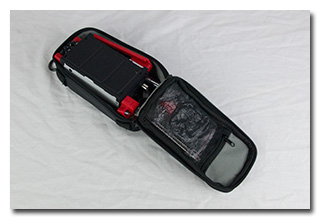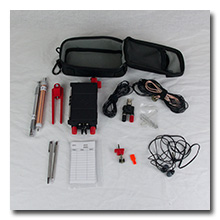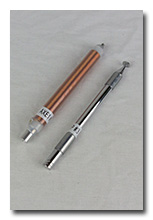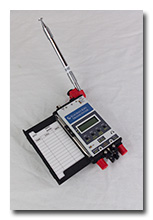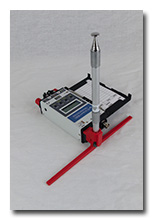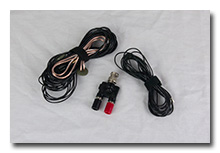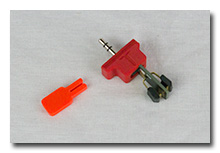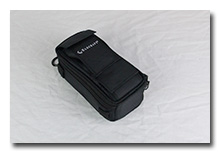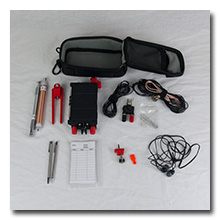by William Eric McFadden
The KH1 Micro Travel Kit is a tiny but complete low-power, CW-only, HF station in a rugged and weather-resistant case that is designed for transport by bicycle or foot. While the KH1 Micro Travel Kit is, essentially, the KH1 Edgewood Package (link) as shipped by Elecraft, I've made some small but significant changes to the station to better suit my operating style.
The KH1 Micro Travel Kit is currently under development. Photos may not represent the current state of the station. This page will change as various ideas are tested and accepted or rejected.
-
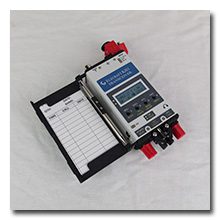 The heart of the KH1 Micro Travel Kit is an Elecraft KH1
low-power transceiver that came to me as part of the KH1 Edgewood Package and it
is equipped with
the KHATU1 Internal Automatic Antenna Tuner with the associated 4' whip and 13' counterpoise wire,
the KHPD1 Rev B Keyer Paddle,
the KXBT2 11.1v, 2.6Ah Li battery, and
the KHLOG1 Log Tray.
The heart of the KH1 Micro Travel Kit is an Elecraft KH1
low-power transceiver that came to me as part of the KH1 Edgewood Package and it
is equipped with
the KHATU1 Internal Automatic Antenna Tuner with the associated 4' whip and 13' counterpoise wire,
the KHPD1 Rev B Keyer Paddle,
the KXBT2 11.1v, 2.6Ah Li battery, and
the KHLOG1 Log Tray.
The Elecraft KH1, which was designed specifically for handheld, pedestrian-mobile operation, features CW-only coverage of 40, 30, 20, 17, and 15m; an internal ATU that matches a 4' whip on 15, 17, and 20m; six CW keyer memories; and built-in automatic logging of field QSOs. These features, when combined with the transceiver's very small size, very low weight, and very low power consumption, make the KH1 an extraordinary field radio.
My KH1 is essentially stock, as shipped to me, but I've replaced the factory black knobs with Tufteln red knobs (link) and I've installed a Tufteln red power switch guard (link). I've removed the whip-clips from the KH1's back panel, but these might be reinstalled if I find I want to be able to transport the whip clipped to the transceiver.
-
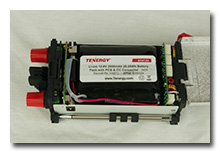 The KH1 is designed to operate using an internal 11.1v, 2.6Ah Li-ion battery, the KXBT2,
the same battery that is specified for use inside the Elecraft KX2.
The KH1 is designed to operate using an internal 11.1v, 2.6Ah Li-ion battery, the KXBT2,
the same battery that is specified for use inside the Elecraft KX2.
The KH1 is equipped with a socket for an external DC source that can be used to power the KH1 and to safely charge the internal battery. If an internal battery is installed and an external power source is connected, the KH1 draws power from the source with the higher voltage.
Given the KH1's extremely low power consumption, I generally haven't felt the need to carry a second battery or external power source for short-duration field operations. It's reassuring to know that the Tufteln KH1 Power Switch Guard (link) I've installed ensures that I won't pull the KH1 out of the bag after a bicycle ride or a hike to find the power switch in the on position and the battery dead.
If I find myself anticipating the need for an external battery, I have a pair of Nitecore NB Air ultra lightweight USB-C PD 5,000mAh power banks (link) and a Tufteln "12V Source from USB-C PD" adapter (link). This combination provides a stable 12v output suitable for use in powering the KH1. These battery banks and adapter cable do not fit in the in the case as part of the KH1 Micro Travel Kit but must be carried separately.
-
The primary antenna in the KH1 Micro Travel Kit is the standard 4' whip that provides coverage of the 15, 17, and 20m bands. To the KH1 Micro Travel Kit, I've added an Elecraft AXE1 40m Antenna Extender (link) to provide coverage of the 30 and 40m bands when using the 4' whip.
A counterpoise wire is required when one operates using the 4' whip; the KH1 Edgewood package comes with a very rugged 13' drag-wire for use on 15, 17, and 20m and the AXE1 40m Antenna Extender comes with a rugged 33' drag-wire for use on 30 and 40m.
For handheld, pedestrian-mobile operation with my KH1, the KH1 Micro Travel Kit includes a Tufteln KH1 Antenna Angle Adapter (link) which places the KH1 at a 30° angle when the 4' whip is held vertically, allowing for easier and better CW keying of the handheld transceiver. (I like the way this red adapter looks on the radio so much that I leave it installed on my KH1 almost all of the time.)
For operating in a "table-top" configuration, the KH1 Micro Travel Kit includes a Tufteln KH1 Right Angle Adapter with Stand (link) which allows the KH1 to be placed flat on a table, with the whip extending straight up; the two adjustable legs stabilize the whole setup.
Recognizing that there will be conditions under which operating into a 4' whip won't be fun or productive, I've come up with an ad hoc end-fed random-wire (EFRW) antenna that is constructed from a binding-post adapter and the 33' and 13' drag-wires that are already integral parts of the KH1 Micro Travel Kit. The longer wire is used as the antenna's radiator and it is supported by a tree branch or a lightweight mast as a vertical, as a sloper, or as an inverted-vee. The shorter wire is used as a single counterpoise wire and is generally placed directly on the ground. The two wires are connected to the KH1's BNC connector using the binding-post adapter and the KH1's internal ATU is used to find a match on the desired frequency.
Because 33' is a half-wave on 20m, the KH1's internal ATU would see a very high impedence on this band and would be expected to fail to find a match for this length of wire on 20m. To allow me to use the rugged 33' wire as a radiator on all the bands the KH1 covers, I've done two things: I've added a button insulator at the 29' point of the wire to mark a fold-back point, and I've added a mini-banana plug socket on the far end of the 33' wire so that I can add a 2' length of wire equipped with a matching mini-banana plug. In practice, I deploy the 33' wire folded back to 29' or I deploy it with the 2' extension installed to create a 35' wire; both lengths, 29' and 35', are nowhere close to being a multiple of a half-wave on any band of interest and the KH1's internal ATU should be able to easily find a match on any of the bands the KH1 covers.
Both the modified 33' wire and the 13' wire are individually wound in a figures-of-eight pattern on a single Tufteln wire-winder for tangle-free storage and quick deployment.
I've tested both configurations of this ad hoc EFRW antenna and both have been shown to work well.
Note to Self: While discussing the KH1 with its designer, Wayne Burdick, N6KR, at FDIM 2024, he assured me that the KH1's final transistor can tolerate an SWR of up to 4:1, so a perfect 1:1 match is not needed.
I don't often try to throw a line into a tree to support a wire antenna. My preference is to use a fiberglass or carbon-fiber telescoping mast to support the wire. My favorite such mast for bicycle-portable or pedestrian-portable operations is an inexpensive Goture Red Fox Super Hard 720 carbon-fiber mast which, with the useless top three sections removed, makes an honest 18' 3½" mast for supporting lightweight wires. This mast collapses to 28" and can be carried on the bicycle or in a backpack. Once on-site, the mast can be bungied vertically to the bicycle, bungeed to a post, leaned into a tree, or held upright on a spike.
I sometimes carry an alternative antenna that is larger than the KH1's 48" whip but much smaller than the ad hoc 35' antenna: a Tufteln 4:1 EFRW antenna (link). This antenna consists of a 15' radiating wire, a 7½' counterpoise wire, and a tiny 4:1 unun. The KH1's internal ATU easily finds a match to this antenna on all bands the the transceiver covers (40-15m) and the 15' length is perfect for vertical deployment on the Goture Red Fox Super Hard 720 carbon-fiber mast. The Tufteln 4:1 EFRW antenna doesn't fit in the KH1 Micro Travel Kit but must be carried separately. (The Tufteln 4:1 EFRW and the aforementioned Nitecore battery bank with USB-C PD interface are kept in a spare Elecraft CS20 case for easy transport.)
-
The KH1 Micro Travel Kit includes a KHPD1 Rev B, the improved version of the CW paddle designed for pedestrian-mobile operation with the KH1. While this two-lever paddle is excellent for use while walking with the KH1, I'm primarily a user of single-lever paddles and and I'm struggling to come to terms with the KHPD1. Since the KH1 Micro Travel Kit is so compact, I have been unable to find a replacement single-lever paddle that is small enough to fit. In the short term, I will carry an inexpensive and lightweight Whiterook MK-33 single-lever paddle which doesn't fit in the case as part of the KH1 Micro Travel Kit but must be carried separately.
As an "emergency back-up paddle", the KH1 Micro Travel Kit includes an N6ARA Tiny Paddle (link) and a Tufteln N6ARA Tiny Paddle Adapter (link) to fit it to the KH1.
-
The KH1 includes a tiny speaker but I prefer to operate with headphones or earbuds. The KH1 Micro Travel Kit includes a pair of Sony MDR-EX15 earbuds. These earbuds work very well so long as I can avoid yanking them out of my ears.
The KH1 Edgewood Package's KHLOG1 Log Tray included a nifty and tiny Zebra pen for logging while operating pedestrian-mobile. I prefer logging with a pencil and when Thomas, K4SWL, informed me that Zebra makes a matching mechanical pencil (link), I wasted no time in ordering myself a pair of them. One of these pencils is carried in the clip on the KHLOG1 Log Tray and the second pencil and the original pen are carried in the bag as emergency spares.
The KH1 Micro Travel Kit includes a set of extra logsheets sized to fit in the KHLOG1 Log Tray.
The KH1 Micro Travel Kit is far too small to accommodate the KH1's user's manual, at least any version of the manual that could be printed in a size that's actually legible. Instead, I've downloaded the latest version of the KH1 manual in PDF format onto my smartphone for easy reference in the field, whether or not I have a cell-signal.
-
The KH1 Edgewood Package included the lovely ES20 Soft Carrying Case (link), which I suspect is manufactured by LowePro for Elecraft. This is the case I use to carry and protect the KH1 Micro Travel Kit.
The ES20 looks small but it might well have been made with Time Lord technology—it seems bigger on the inside. The ES20 easily accommodates the KH1 with attached KHLOG1 Log Tray and KHPD1 paddle, the 4' whip and the AXE1 40m coil, the modified 33' wire and the 13' wire on a wire-winder, the binding-post adapter, the Tufteln Antenna Angle Adapter and the Right Angle Antenna Adapter, the N6ARA paddle and adapter, the Sony earbuds, the extra logsheets, the spare Zebra pen and mechanical pencil, and a selection of steel paperclips to serve as hooks for supporting the far end of the ad hoc wire antenna.
-
I built the KH1 Micro Travel Kit to encourage me to engage in human-powered-transport field operations. This station is, by far, the smallest and lightest HF station I've yet built, and is well suited to operations while bicycle- or pedestrian-portable, and it's the only station I have that's suited for pedestrian-mobile CW operation, i.e., CW operation while actually walking or hiking.
Biking-
The KH1 Micro Travel Kit is so small that it fits in my bicycle's rear trunk box along with my wallet, tools, spare inner tube, and a snack. If I were to feel the need to carry it, the aforementioned Goture Red Fox Super Hard 720 carbon-fiber mast would be bungied to my bicycle's top tube for transport and, once at the operating site, the mast could be bungied vertically to the bicycle, allowing the kickstand-equipped bicycle to serve as a stable tripod for the mast as it supports the ad hoc EFRW antenna.
Bicycle-portable operations I've performed using the KH1 Micro Travel Kit include...
- Strouds Run State Park on 2026-01-08.
- Strouds Run State Park on 2025-12-28.
- Strouds Run State Park on 2025-12-23.
- Strouds Run State Park on 2025-10-17.
- Strouds Run State Park on 2025-10-10.
- Strouds Run State Park on 2025-02-25.
- Strouds Run State Park on 2024-12-30.
- Strouds Run State Park on 2024-12-28.
- Strouds Run State Park on 2024-12-26.
- Strouds Run State Park on 2024-12-17.
- Strouds Run State Park on 2024-12-08.
- Strouds Run State Park on 2024-11-24.
- Strouds Run State Park on 2024-11-17.
- Lake Hope State Park via Moonville Rail Trail on 2024-10-20.
- Lake Hope State Park via Moonville Rail Trail on 2024-08-11 with W8VQ.
- Lake Hope State Park via Moonville Rail Trail on 2024-06-14.
-
The KH1 Micro Travel Kit travels well in a lightweight backpack along with my Goture Red Fox Super Hard 720 carbon-fiber mast, spike, bungies, a towel1, bug-spray, etc...
For really short hikes, I might just clip the KH1 Micro Travel Kit to a belt-loop.
Trail hikes I've made while carrying the KH1 Micro Travel Kit include...
- Battleship North Carolina State Historic Site on 2025-05-10.
- Camp Nelson National Monument on 2024-08-24.2
-
Footnotes:
[1] "A towel, (the Hitchhikers Guide to the Galaxy) says, is about the
most massively useful thing an interstellar hitchhiker can have. Partly it has great practical
value — you can wrap it around you for warmth as you bound across the cold moons of
Jaglan Beta; you can lie on it on the brilliant marble-sanded beaches of Santraginus V,
inhaling the heady sea vapours; you can sleep under it beneath the stars which shine so redly
on the desert world of Kakrafoon; use it to sail a mini raft down the slow heavy river Moth;
wet it for use in hand-to- hand-combat; wrap it round your head to ward off noxious fumes or to
avoid the gaze of the Ravenous Bugblatter Beast of Traal (a mindboggingly stupid animal, it
assumes that if you can't see it, it can't see you — daft as a bush, but very ravenous);
you can wave your towel in emergencies as a distress signal, and of course dry yourself off
with it if it still seems to be clean enough. More importantly, a towel has immense
psychological value. For some reason, if a strag (strag: non-hitch hiker) discovers that a
hitch hiker has his towel with him, he will automatically assume that he is also in possession
of a toothbrush, face flannel, soap, tin of biscuits, flask, compass, map, ball of string,
gnat spray, wet weather gear, space suit etc., etc. Furthermore, the strag will then happily
lend the hitch hiker any of these or a dozen other items that the hitch hiker might
accidentally have 'lost'. What the strag will think is that any man who can hitch the length
and breadth of the galaxy, rough it, slum it, struggle against terrible odds, win through, and
still knows where his towel is is clearly a man to be reckoned with." — Douglas Adams,
The Hitchhiker's Guide to the Galaxy
[2] This was a very short hike and the KH1 Micro Travel Kit was clipped to my belt-loop.
Attributions: KH1 advertisement converted to JPG from high-resolution PDF downloaded from Elecraft.
